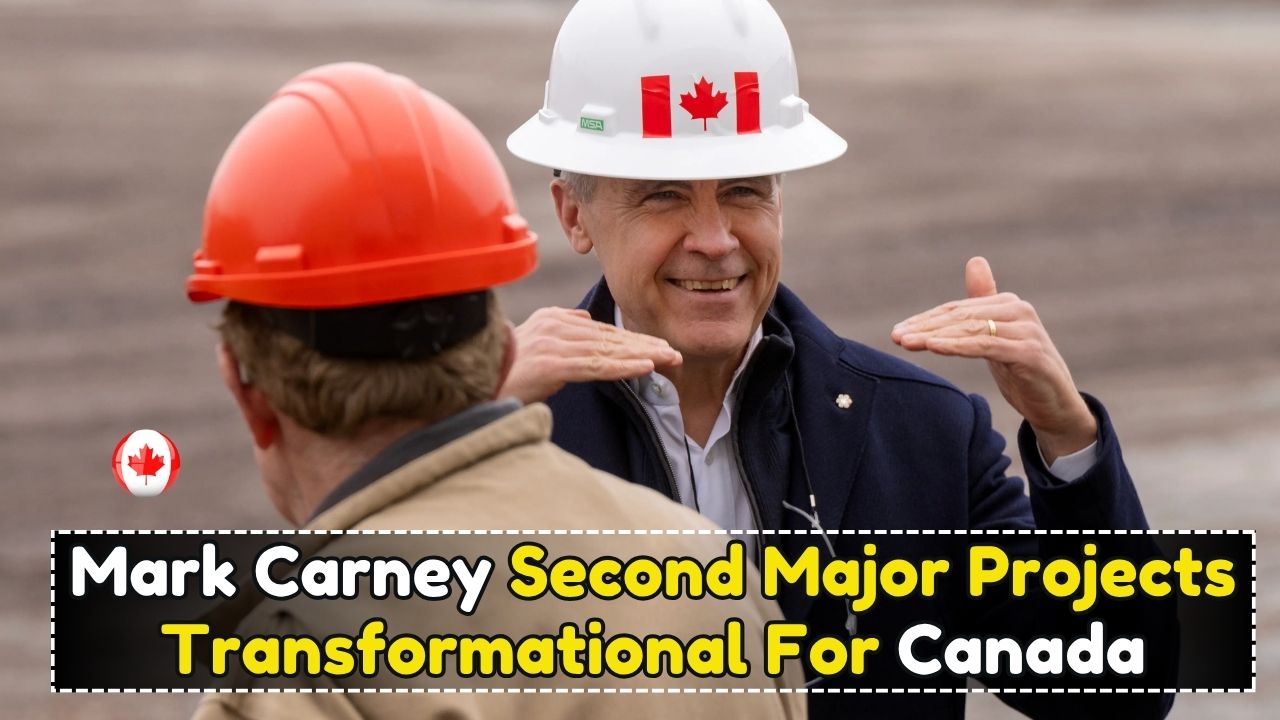Prime Minister Mark Carney has announced a second list of large scale projects that his government is sending to the new Major Projects Office for possible fast track approval. The package includes major mining, energy and hydroelectric developments that the federal government says can reshape regional economies, support the energy transition and strengthen Canada’s role as a reliable supplier of critical resources.
Carney described each project on the list as transformational in its own right. He also argued that their impact will be significantly greater because they fit into national strategies on clean energy, critical minerals and export growth. The announcement underlines the central role that the Major Projects Office will play in trying to speed up approvals while still respecting environmental and legal obligations.
New Round Of Projects Sent To The Major Projects Office

Speaking on Thursday near the site of the Ksi Lisims liquefied natural gas project, Prime Minister Carney confirmed that his government is forwarding a second group of large projects to the Major Projects Office, often referred to as the MPO. The office, established in August as one of Carney’s early moves in government, is responsible for coordinating reviews of large and complex developments with national economic significance.
Carney framed the new list as a deliberate package, not a random collection of proposals. In his remarks he said that each project has the potential to transform a region and that together they support a larger strategy to improve Canada’s competitiveness in a world that is racing to secure energy and critical minerals.
Once referred to the MPO, each project will undergo an integrated review. The office will then return recommendations to cabinet, which will decide whether a particular project should be given a national interest designation and what kind of support or streamlining it should receive.
Short Summary
Key Point |
Details |
|---|---|
Main Announcement |
Second batch of major projects sent to the federal Major Projects Office for review and potential fast track approval. |
Key Projects |
Ksi Lisims LNG in British Columbia, Sisson Mine in New Brunswick, Crawford Nickel Project in Ontario, Nouveau Monde Graphite Phase 2 in Quebec, Iqaluit Nukkiksautiit Hydro Project in Nunavut. |
Carney’s Claim |
Says each project is transformational and part of wider national strategies to boost competitiveness, energy security and critical mineral supply. |
Role Of MPO |
New federal office created in August to coordinate reviews, identify priority projects and recommend national interest designation. |
Alberta Question |
No new Alberta project in this batch; Carney says talks with the province on a memorandum of understanding are progressing. |
Opposition Response |
Conservative Leader Pierre Poilievre accuses Carney of taking credit for projects that would have proceeded anyway. |
Official Site Link |
Overview Of The Newly Announced Projects
The second list of projects spans several provinces and territories and touches on both traditional resource development and clean energy.
Crawford Nickel Project In Ontario
The Crawford Nickel Project is positioned in what Carney described as the world’s second largest nickel reserve. According to the prime minister, the project aims to produce high quality, low carbon nickel that is essential for battery manufacturing and green steel production. By advancing this project, the government hopes to secure a stronger foothold in the global supply chain for electric vehicles and clean industrial technologies.
Iqaluit Nukkiksautiit Hydro Project In Nunavut
The Iqaluit Nukkiksautiit Hydro Project is being promoted as a turning point for Nunavut’s capital. Iqaluit currently relies heavily on a diesel power plant, which is costly, polluting and vulnerable to supply interruptions. The proposed hydro facility has already received millions of dollars in federal funding for engineering and design work.
Carney called the project a breakthrough for Arctic sovereignty and sustainability. He noted that it would be Nunavut’s first fully Inuit owned hydro energy project, combining energy security, climate action and Indigenous economic participation in one development.
Ksi Lisims LNG Project
Near the location of Carney’s announcement is the Ksi Lisims LNG project. It is expected to produce around 12 million tonnes of liquefied natural gas per year, largely intended for export to Asian markets where demand for LNG continues to grow.
Carney stressed Canada’s resource advantage, pointing out that the country holds the world’s fourth largest natural gas reserves. He said Canada has the potential to supply up to 100 million tonnes of new LNG exports to Asia annually. He also described Ksi Lisims as one of the world’s cleanest LNG operations, claiming that projected emissions are far below the global average as a result of design choices and power sources.
Sisson Mine In New Brunswick
The Sisson Mine project in New Brunswick focuses on the production of tungsten, which Carney highlighted as the strongest metal in the world. He argued that the mine would position Canada as a reliable supplier for steel manufacturing, defence applications and protective equipment. In a global environment where secure and ethical sources of critical minerals are increasingly important, the government sees Sisson as a strategic asset.
Nouveau Monde Graphite Phase 2 In Quebec
The Nouveau Monde Graphite Phase 2 project in Quebec aims to expand production of graphite, another key input in battery technology. By supporting this project, the federal government is trying to reinforce Quebec’s emerging role as a hub for battery and electric vehicle supply chains, linking resource extraction, processing and advanced manufacturing.
Strategic Importance For Competitiveness And Energy Transition
Carney repeatedly framed the package as part of broader national strategies. On energy, he argued that Canadian LNG can help Asian economies lower emissions by replacing higher carbon fuels while global renewable capacity continues to scale up. On critical minerals, he pointed to nickel, tungsten and graphite as essential ingredients in defence systems, advanced manufacturing and clean technologies.
The government’s message is that accelerating these projects, while respecting environmental standards, will allow Canada to compete effectively with other resource rich countries that are moving quickly to lock in supply agreements and investment.
At the same time, Carney presented the Iqaluit hydro project as an example of how large projects can advance reconciliation and Indigenous ownership. By backing a one hundred percent Inuit owned hydro facility, the federal government hopes to show that major developments in the North can be designed around local control and long term sustainability.
Alberta’s Absence And Talks On A Separate Understanding
One notable feature of the announcement was the absence of new Alberta based projects in the second batch. Reporters quickly asked Carney whether this reflected tensions with the province or a lack of viable proposals.
Carney responded that discussions with Alberta are ongoing under what both sides describe as a memorandum of understanding. He rejected suggestions of a breakdown and said he is personally encouraged by the progress. According to the prime minister, there are still a few issues to be resolved but he expects further movement in the coming weeks.
The comment suggests that a separate arrangement or tailored approach may be in the works for Alberta, which has its own priorities on energy development, emissions policy and infrastructure.
Opposition Criticism From Pierre Poilievre
Shortly after Carney’s event, Conservative Leader Pierre Poilievre spoke at a separate gathering in British Columbia’s Okanagan region and sharply criticised the prime minister’s handling of major projects.
Poilievre argued that the Liberal budget has done little to address structural challenges in the Canadian economy. He also accused Carney of taking credit for projects that are already in motion. Using a colourful metaphor, he compared the prime minister to a rooster that believes it made the sun rise simply because it crowed at dawn. In Poilievre’s view, the government is merely arriving at project sites to claim credit for developments that would proceed regardless.
The critique fits into a broader Conservative narrative that federal regulations and approval processes remain too slow and uncertain, despite the creation of the Major Projects Office.
Background: First List Of Fast Track Projects
This is the second time the Carney government has forwarded a group of projects to the MPO. Two months earlier, the prime minister announced the first five projects selected for fast track consideration.
That initial list included a Montreal port expansion, a small modular nuclear power plant in Ontario, an expansion of a liquefied natural gas facility in British Columbia and two mining projects in Saskatchewan and British Columbia. Conservatives dismissed the first batch as low hanging fruit, arguing that development on those projects was already well advanced.
The government responded that starting with projects at different stages would give the MPO a range of examples to test its new processes and identify bottlenecks.
Mandate And Funding Of The Major Projects Office
The Major Projects Office was one of Carney’s signature early initiatives after winning the federal election. The federal budget tabled last week proposes spending 213.8 million dollars over five years to support the office’s operations.
Dawn Farrell, the MPO’s chief executive officer, told members of the House of Commons standing committee on environment and sustainable development that the stage of each project will be a key factor in the review process. She noted that many proposals are either far in the future or already deep into execution. The office wants to prioritise projects that are executable within a shorter time frame so that results can be seen more quickly.
So far no project has received a national interest designation. Such a designation would give a project access to special treatment that could include targeted exemptions or coordinated handling under complex federal statutes such as the Fisheries Act, the Species At Risk Act and the Impact Assessment Act.
Under the current framework, once a project is reviewed by the MPO, the office returns recommendations to the government. Cabinet retains the final authority on whether to grant national interest status and on any related adjustments to regulatory pathways.
The government has also signalled plans to introduce legislation that would make the Major Projects Office a separate entity, similar to a Crown corporation, rather than a unit within the Privy Council Office. Supporters say that greater independence and a clearer mandate will help the office coordinate approvals across departments and deliver the faster timelines that investors and communities are demanding.
Frequently Asked Questions
Q1. What is the Major Projects Office and why was it created
The Major Projects Office is a new federal body set up to coordinate reviews of large, complex projects that have national economic or strategic importance. It was created to simplify and accelerate federal approvals, reduce duplication between departments and provide clearer timelines for investors and communities, while still respecting environmental and legal requirements.
Q2. Which projects are included in the second batch sent to the MPO
The second batch includes the Ksi Lisims LNG project in British Columbia, the Sisson Mine in New Brunswick, the Crawford Nickel Project in Ontario, the Nouveau Monde Graphite Phase 2 project in Quebec and the Iqaluit Nukkiksautiit Hydro Project in Nunavut.
Q3. Has any project received a national interest designation yet
No. According to the information available so far, no project has been granted a national interest designation. The MPO is still reviewing the first and second batches and will provide recommendations to the federal government, which makes the final decision.
Q4. Why is Alberta not included in the latest project list
There were no new Alberta projects in the second batch announced by Prime Minister Carney. He said that the federal government and the Alberta government are working under a memorandum of understanding and that discussions are progressing. Details of any Alberta specific arrangement have not yet been announced publicly.
Q5. How much funding has been allocated to the Major Projects Office
The latest federal budget proposes spending 213.8 million dollars over five years on the Major Projects Office. This funding is intended to build the office’s capacity, support integrated project reviews and help establish it as a separate entity similar to a Crown corporation in the future.
For More Information Click HERE











